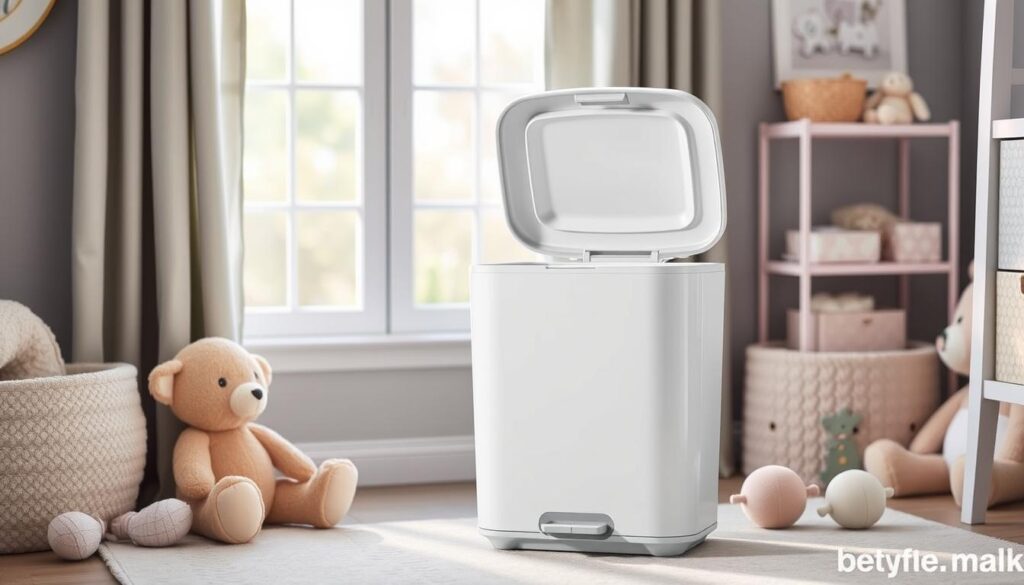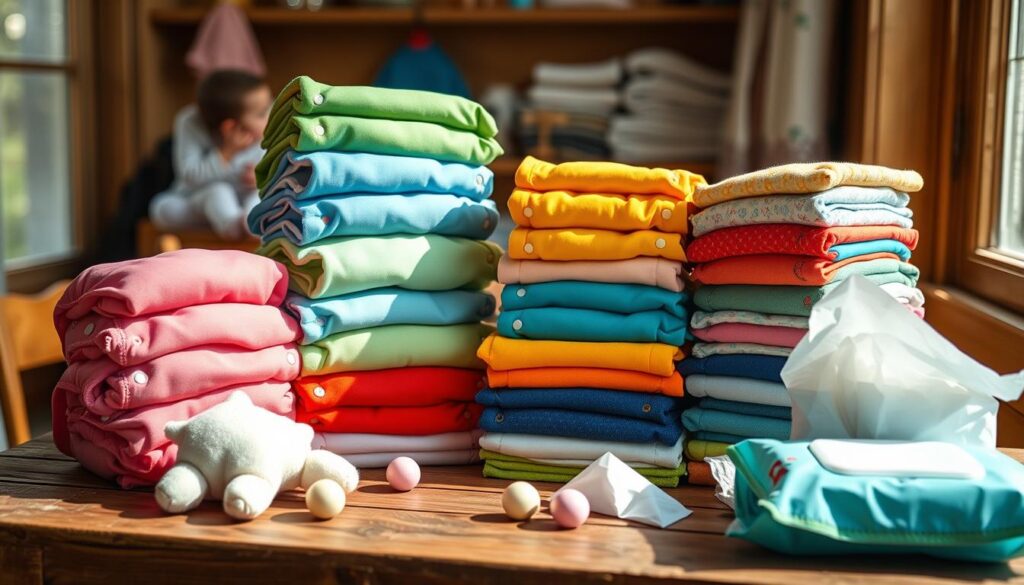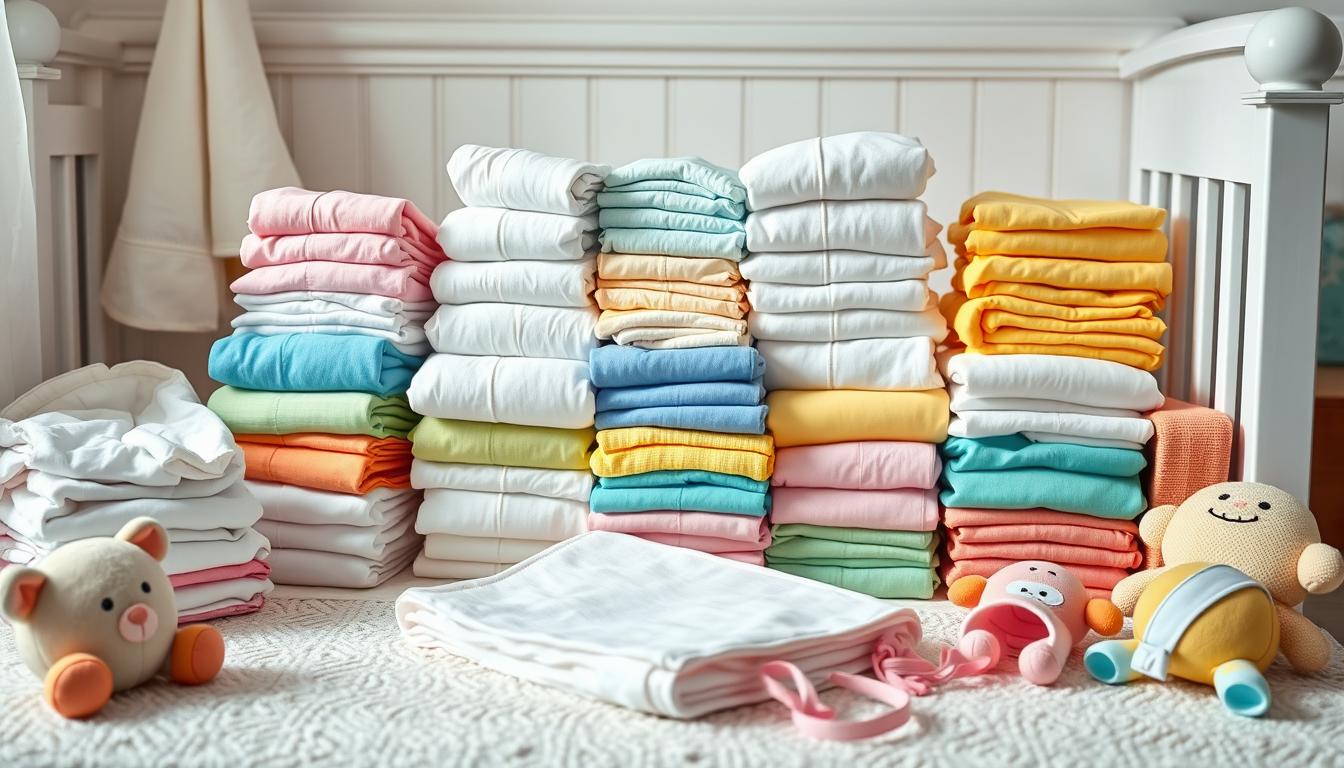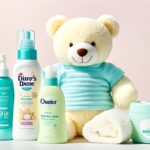Baby diapering essentials. Starting as a new parent can be daunting, especially with diapering. But don’t worry, we’ve got you covered. This guide will help you understand the basics of diapering. You’ll learn about choosing the right diapers, managing diaper rash, and keeping odors away.
Key Takeaways
- Discover the essentials of baby diapering, including diapers, wipes, and rash creams.
- Understand the differences between disposable and cloth diapers to make an informed choice.
- Learn about the importance of changing pads, diaper bags, and pails for a clean and organized diapering experience.
- Explore environmentally friendly diaper disposal options and the benefits of cloth diapering.
- Gain valuable tips and tricks to make diapering a breeze for both you and your baby.
Diapers: The Foundation
Diapers are key to your baby’s care. You can choose between disposable and cloth diapers. Each has its own benefits, and knowing the differences helps you pick the best for your family.
Disposable vs. Cloth Diapers
Disposable diapers are super convenient. They’re easy to use and always available. Cloth diapers, however, are better for the planet since they can be washed and reused.
When deciding, think about your lifestyle, what you prefer, and the planet. It’s crucial to have the right diaper sizes and enough diapers as your baby grows. The right fit and enough diapers keep your baby comfy and prevent accidents.
“Choosing the right diapers is crucial for your baby’s comfort and your peace of mind.”
Whether you choose disposable or cloth diapers, making a smart choice is important. It makes diapering easier and keeps your baby happy and healthy.
Baby Wipes: Gentle Cleansing
As you navigate the diapering journey with your little one, baby wipes are essential. They play a key role in keeping your baby’s delicate skin clean during diaper changes. Look for soft, hypoallergenic wipes that are free of harsh chemicals to avoid skin irritation.
Munchkin, Huggies, and Pampers are top brands for baby wipes. They offer a variety of options to meet your needs. These wipes are made to clean your baby’s skin gently but effectively, leaving it fresh and comfortable. Many include aloe vera and vitamin E to soothe and nourish the skin.
Consider the convenience of baby wipes. Choose ones in resealable packs or travel-friendly containers. This makes them easy to use during diaper changes, whether at home or on the go. The right baby wipes can make diapering easier, keeping your little one’s skin clean and comfortable.
“Baby wipes are an essential tool in our household, providing a gentle and effective way to keep my baby’s skin healthy during those frequent diaper changes.”
Investing in quality baby wipes can greatly improve the diapering experience. By picking wipes that are gentle on your baby’s skin, you ensure a comfortable and stress-free routine. This lets you enjoy the joyful moments with your little one.
Diaper Rash Cream: Protecting Delicate Skin
As a parent, you want to keep your baby’s skin safe, especially from diaper rash. Diaper rash creams can help soothe and heal irritated skin. They come in different formulas to tackle various skin issues.
Types of Diaper Rash Creams
There are two main types of diaper rash cream. Zinc oxide creams create a physical barrier to protect the skin. Petroleum-based creams lock in moisture and prevent irritation.
Applying Diaper Rash Cream
Applying diaper rash cream right is key. Clean the area gently and dry it before applying the cream. Make sure to cover all irritated spots, including folds. Reapply with each diaper change to keep the skin protected.
Using a good skin protection cream and applying it correctly can ease your baby’s discomfort. It also helps prevent more irritation from diaper rash.
Changing Pads: A Clean Surface
Having a clean and comfy surface for diaper changes is key. Changing pads are the answer, offering a special spot for this task. You can choose from portable changing pads or stationary changing pads. Both ensure a clean and safe place for your baby.
Portable vs. Stationary Changing Pads
For parents always on the move, portable changing pads are a must. They’re light, foldable, and fit in your diaper bag. This means you can have a clean spot for diaper changes anywhere.
Stationary changing pads are for home use. They sit on a changing table or flat surface in the nursery. These pads are bigger and softer, with safety straps to keep your baby safe.
- Portable changing pads are great for diaper changes on the go
- Stationary changing pads offer a cozy spot at home
- Both types ensure a clean and safe area for diaper changes
Choosing a portable or stationary changing pad makes diaper time easier. It keeps your baby comfy and safe.
Diaper Bags: Essentials on the Go
Going out with your little one? A good diaper bag is a must. Diaper bags have many styles and features. They help you stay organized and ready for any diapering needs.
Features to Look for in Diaper Bags
When looking for the right diaper bag, think about these features:
- Multiple compartments: A bag with many pockets helps keep things like diapers, wipes, and clothes organized and easy to find.
- Insulated pockets: These pockets keep bottles, formula, or snacks at the right temperature.
- Durable, waterproof material: Choose a bag that’s easy to clean and can handle spills and messes.
- Comfortable straps: Padded or adjustable straps make carrying a full diaper bag more comfortable, even for a long time.
- Stroller attachments: Many bags have clips or rings to attach to your stroller, keeping your hands free.
By looking for these features, you can find a diaper bag that meets your needs. It will make your outings with your little one easier.
Diaper Pails: Managing Odors
Keeping your nursery fresh and odor-free is a top priority for new parents. Diaper pails are key in this effort. They are made to hold and manage the smells of used diapers, making your nursery clean and comfy for your baby.
Diaper pails have airtight seals and special features to fight off diaper smells. They use advanced filters and carbon to catch and get rid of bad smells. This keeps your home’s air fresh and clean.
Key Features of Diaper Pails
- Airtight Sealing – Diaper pails with airtight lids keep smells trapped, stopping them from spreading.
- Odor Control Mechanisms – Many have built-in filters, baking soda, or scented liners to fight off diaper smells.
- Convenient Design – Features like foot pedals, small sizes, and easy-empty designs make using them simple.
- Compatibility with Diaper Sizes – Pick a diaper pail that fits your baby’s diaper size and type.
| Feature | Benefit |
|---|---|
| Airtight Sealing | Helps contain odors and prevent them from escaping into the room. |
| Odor Control Mechanisms | Actively neutralize diaper odors with features like carbon filters and baking soda compartments. |
| Convenient Design | Easy-to-use features like foot pedals and compact sizes make diaper disposal a breeze. |
| Compatibility with Diaper Sizes | Ensure the diaper pail can accommodate the size and type of diapers your baby uses. |
Choosing a good diaper pail helps manage diaper odors and keeps your nursery fresh. This simple tool is crucial for a clean diapering routine.

Baby diapering essentials: A Comprehensive List
Getting ready for your baby means having all the diapering supplies ready. You’ll need diapers, wipes, rash creams, and changing pads. This list will help you stock up for your baby’s diapering needs.
Start with a good supply of diapers. You might want both disposable and cloth diapers. Disposable diapers are easy, while cloth diapers are better for the planet.
Soft baby wipes are key for cleaning up. Choose ones that are gentle on your baby’s skin.
You’ll also need diaper rash creams to prevent and treat irritation. Look for creams with zinc oxide or petroleum to protect your baby’s skin.
| Essential Diapering Supplies | Quantity Needed |
|---|---|
| Diapers (disposable or cloth) | Newborn: 10-12 per day 6-12 months: 6-8 per day |
| Baby Wipes | Newborn: 3-4 packs per week 6-12 months: 2-3 packs per week |
| Diaper Rash Cream | 1-2 small tubes/jars |
| Changing Pads | 2-3 (1 stationary, 1-2 portable) |
| Diaper Bags | 1-2 (1 large, 1 small/medium) |
| Diaper Pails | 1 |
Don’t forget a comfy changing pad for home and on the go. Diaper bags are also great for keeping everything organized.
A diaper pail helps keep odors away and makes cleaning up easier. With this list, you’ll be ready for all your baby’s diapering needs.
Diaper Disposal: Environmentally Friendly Options
As parents, we all want to protect the environment. Finding eco-friendly ways to dispose of used diapers is key. While throwing them away is common, many are turning to composting.
Composting Disposable Diapers
Composting disposable diapers is a big step towards reducing waste. It breaks down the diapers into soil that feeds your garden. Composting disposable diapers helps avoid landfills and gives you a useful resource.
- Choose diapers made from biodegradable materials for composting.
- Make sure your compost bin can handle the diapers’ size and volume.
- Turn and aerate the compost often to help it break down.
- Keep an eye on the compost’s moisture and temperature for best results.
By composting, you lessen your family’s environmental impact. It’s a step towards a greener future.
| Disposal Method | Environmental Impact | Ease of Implementation |
|---|---|---|
| Traditional Trash Disposal | High – Diapers end up in landfills, contributing to waste buildup. | Easy – Convenient but less eco-friendly. |
| Composting Disposable Diapers | Low – Organic materials are broken down and turned into nutrient-rich soil. | Moderate – Requires dedicated compost bin and maintenance. |
Exploring green options for diaper disposal like composting helps us all. It makes a cleaner, greener future for our kids.
Cloth Diapering: A Reusable Alternative
Parents are looking for eco-friendly diapering options. Cloth diapers are a great choice. They are durable, sustainable, and can save money over time. Knowing the different types and how to care for them is key.
Types of Cloth Diapers
The cloth diaper market has many options. Here are a few:
- Prefold Diapers: These classic diapers need a cover to prevent leaks.
- All-in-One Diapers: They have everything you need in one piece.
- Pocket Diapers: You can add your own absorbent material to these diapers.
Washing and Caring for Cloth Diapers
Keeping cloth diapers in good shape is important. Use mild detergent and avoid fabric softeners. Air-drying or low-heat machine drying is best.
| Cloth Diaper Care Tips | Recommended Practices |
|---|---|
| Washing | Pre-rinse, use mild detergent, avoid fabric softeners |
| Drying | Air-dry or use low-heat machine drying |
| Storage | Keep diapers in a cool, dry place to prevent mildew |
Learning about cloth diapers and how to care for them is rewarding. It’s a green and cost-effective choice for your baby.

Diapering Supplies: Additional Necessities
Diapers, wipes, and changing pads are the basics. But, there are more items that can make diapering easier and more comfortable. These include diaper rash ointments and disposal bags. They help keep your baby’s skin healthy and your home tidy.
A good diaper rash cream is a must. It soothes and protects your baby’s skin. Look for creams with zinc oxide or petroleum to keep skin dry and safe.
Diaper disposal bags are also key. They let you throw away used diapers quickly and quietly. This keeps your nursery smelling fresh and clean.
Diaper organizers and storage containers are great too. They keep your additional diapering supplies tidy and easy to find. Use bins, baskets, or diaper caddies for things like cotton swabs and ointments.
Having these extra additional diapering supplies makes diaper changes smoother. It keeps your baby comfortable and happy.
“Keeping your baby’s skin healthy and happy is a top priority, and the right additional supplies can make all the difference.”
Diapering Tips and Tricks
Dealing with baby diapers can be tough, but with the right tips, it gets easier. You’ll learn how to put on diapers right and store them well. These tips will help you take great care of your baby.
Proper Diaper Placement
A snug and comfy fit is key to avoid leaks and rashes. Here’s how to do it right:
- Center the diaper at the back of your baby’s waist
- Bring the front panel up between your baby’s legs
- Secure the tabs firmly, but not too tight
- Check for any gaps or wrinkles that could allow leaks
Diapering Supplies Organization
Keep your diaper area neat and stocked for quick changes. Use a diaper caddy or organizer for:
- Diapers
- Wipes
- Diaper rash cream
- Clean cloths or paper towels
- Hand sanitizer
Diaper Disposal Hacks
Keep your nursery fresh and clean with these tips:
- Use a diaper pail with a locking lid and odor-trapping technology
- Wrap soiled diapers in a plastic bag before placing them in the pail
- Take out the trash frequently to prevent buildup of dirty diapers
By following these tips, you’ll make diaper changes easier and keep your baby clean and comfy. Soon, you’ll be a pro at diapering!
| Product | Price | Quantity | Location | Shipping |
|---|---|---|---|---|
| Diapering Supplies | US $19.18 per item | 10 items available | Shenzhen, China | Estimated delivery time: more than 11 business days International shipping subject to customs processing and additional charges. |
Conclusion
Caring for your newborn’s diapering needs is key. You need to know the baby diapering essentials and best practices. Having the right diapers, wipes, creams, and accessories keeps your baby comfortable and clean.
Every baby is different. So, you might need to change your diapering routine often. This helps you find what works best for your little one.
The diapering supplies we talked about are very important. From top-notch disposable or reusable cloth diapers to soothing diaper rash creams, they all play a big role. Using the right products and techniques makes caring for your baby easier.
It’s all about finding the right balance. You need to understand your baby’s needs, stay organized with supplies, and adjust as they grow. With the tips from this article, you can make informed choices. This helps you create a diapering routine that suits you and your baby.





